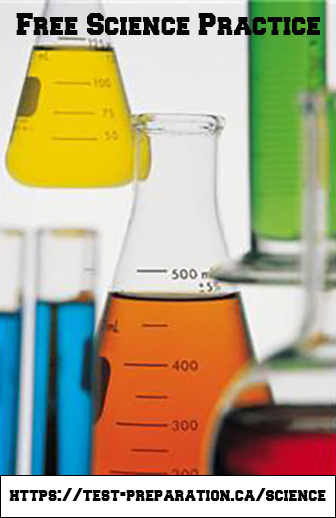
High School Chemistry Practice Questions
- Posted by Brian Stocker MA
- Date April 6, 2014
- Comments 5 comments
Basic Chemistry Practice Questions
1. What are the differences, if any, between mixtures and compounds?
a. A mixture is homogeneous, and the properties of its components are retained, while a compound is heterogeneous and its properties are distinct from those of the elements combined in its formation.
b. A mixture is heterogeneous, and the properties of its components are retained, while a compound is homogeneous and its properties are distinct from those of the elements combined in its formation.
c. A mixture is heterogeneous, and the properties of its components are changed, while a compound is homogeneous and its properties are similar to those of the elements combined in its formation.
d. A compound is heterogeneous, and the properties of its components are retained, while a mixture is homogeneous and its properties are distinct from those of the elements combined in its formation.
2. What are the differences, if any, between chemical changes and physical changes?
a. During a physical change, some aspect of the physical properties of matter are altered, but the identity of the substance remains constant. Chemical changes involve the alteration of both a substance’s composition and structure.
b. During a chemical change, some aspect of the physical properties of matter are altered, but the identity of the substance remains constant. Physical changes involve the alteration of both a substance’s composition and structure.
c. During a physical change, no aspects of the physical properties of matter are altered, but the identity of the substance remains constant. Chemical changes involve the alteration of both a substance’s composition and structure.
d. There is no substantive difference between chemical and physical changes.
3. H = Hproducts – Hreactants is the formula used to determine a ______________.
a. Change in hydration
b. Change in haploid bond
c. Change in heat content
d. Change in hypothesis
4. In an _______ reaction, the heat content of the products is ______ than the heat content of the reactants, while in an _________ reaction, the heat content of the products is ______ than the heat content of the reactants.
a. Exothermic, greater, endothermic, less
b. Endothermic, less, exothermic, greater
c. Exothermic, greater, exothermic, less
d. Endothermic, greater, exothermic, less
5. The equation E = mc2 is based on the ______________________, and states that ______equals _____ times the _____________2.
a. The equation E = mc2 is based on the 2nd Law of Thermodynamics, and states that Mass equals Energy times (the Velocity of light) 2.
b. The equation E = mc2 is based on the Law of Conservation of Mass and Energy, and states that Energy equals Mass times (the Velocity of light) 2.
c. The equation E = mc2 is based on the 1st Law of Thermodynamics, and states that Mass equals Energy times (the Velocity of sound) 2.
d. The equation E = mc2 is based on the Law of Conservation of Mass and Energy, and states that the Velocity of light equals Energy times (the Mass) 2.
6. When a measurement is recorded, it includes the _________ ________, which are all the digits that are certain plus one uncertain digit.
a. Major figures
b. Significant figures
c. Relative figures
d. Relevant figures
7. The _______ _______ is based on the lowest theoretical temperature, called ________ _______.
a. Kelvin scale, absolute zero
b. Celsius scale, absolute zero
c. Kelvin scale, boiling point of water
d. Centigrade scale, freezing point of water
8. Through experiments and calculations, ________ ______ has been verified to be _________o on the _________ scale.
a. Through experiments and calculations, absolute zero has been verified to be – 273.15o on the Celsius scale.
b. Through experiments and calculations, unconditional zero has been verified to be 0o on the Kelvin scale.
c. Through experiments and calculations, absolute null has been verified to be -100o on the Celsius scale.
d. Through experiments and calculations, absolute zero has been verified to be – 273.15o on the Kelvin scale.
9. When using the scientific notation system to express large numbers, move the _______ ______ until _____ digit(s) remain(s) to the left, then indicate the number of moves of the decimal point as the _______ __ ___.
a. When using the scientific notation system to express large numbers, move the decimal point until only two digits remain to the left, then indicate the number of moves of the decimal point as the exponent of 10.
b. When using the scientific notation system to express large numbers, move the decimal until only one digit remains to the left, then indicate the number of moves of the decimal point as the exponent of 2.
c. When using the scientific notation system to express large numbers, move the decimal until only three digits remain to the left, then indicate the number of moves of the decimal point as the exponent of 10.
d. When using the scientific notation system to express large numbers, move the decimal until only one digit remains to the left, then indicate the number of moves of the decimal point as the exponent of 10.
10. In science, ________ indicates the __________ or ___________ of a measurement, while _______ indicates the ________ of a measurement to its known or accepted value.
a. In science, accuracy indicates the reliability or reproducibility of a measurement, while precision indicates the proximity of a measurement to its known or accepted value.
b. In science, exactitude indicates the reliability or reproducibility of a measurement, while contiguity indicates the remoteness of a measurement to its known or accepted value.
c. In science, precision indicates the reliability or reproducibility of a measurement, while accuracy indicates the proximity of a measurement to its known or accepted value.
d. In science, uncertainty indicates the realism or possibility of a measurement, while precision indicates the distance of a measurement to its known or accepted value.
Answer Key
1. B
A mixture is heterogeneous, and the properties of its components are retained, while a compound is homogeneous and its properties are distinct from those of the elements combined in its formation.
2. A
During a physical change, some aspect of the physical properties of matter are altered, but the identity of the substance remains constant. Chemical changes involve the alteration of both a substance’s composition and structure.
Note: Examples of physical changes include breaking glass, cutting wood and melting ice. Sometimes, the process can be easily reversed. Restoration of the original form is not possible following a chemical change.
3. C
H = Hproducts – Hreactants is the formula used to determine a change in heat content.
4. D
In an Endothermic reaction, the heat content of the products is greater than the heat content of the reactants, while in an exothermic reaction, the heat content of the products is less than the heat content of the reactants.
Because it is virtually impossible to measure the total energy of molecules, the experimental data typically used with reactions is the change in heat content known as enthalpy.
5. B
The equation E = mc2 is based on the Law of Conservation of Mass and Energy, and states that Energy equals Mass times the Velocity of light.
6. B
When a measurement is recorded, it includes the significant figures, which are all the digits that are certain plus one uncertain digit.
7. A
The Kelvin scale is based on the lowest theoretical temperature, called absolute zero.
8. A
Through experiments and calculations, absolute zero has been verified to be – 273.15o on the Celsius scale.
9. A
When using the scientific notation system to express large numbers, move the decimal point until only two digits remain to the left, then indicate the number of moves of the decimal point as the exponent of 10.
10. C
In science, precision indicates the reliability or reproducibility of a measurement, while accuracy indicates the proximity of a measurement to its known or accepted value.
Note: Regardless of the precision or accuracy of a measurement, all measurements include a degree of uncertainty, dependent on limitations of the measuring instrument and the skill with which the measurement is completed.
Date Published: Sunday, April 6th, 2014
Date Modified: Thursday, July 13th, 2023
Next post
How to Solve Quadratic Equations - Tutorial, Examples and Practice Questions
You may also like

Listening Comprehension Practice – Solving a Problem


5 Comments
I am having difficulty with this format – any others?
Can u explain 4?
I can explain this to you. An exothermic reaction produces heat. This heat is given off to the surroundings (removed from the system) so that the balance of energy stored as heat in the product(s) of the reaction is less than the balance of energy stored as heat in the reactants. Conversely, in an endothermic reaction heat is absorbed from the surroundings (added to the system) so that the balance of energy stored as heat in the products is greater than the balance of energy stored as heat in the reactants.
Thank you! I was wondering about the same thing.
Question 3 – what is a haploid bond?